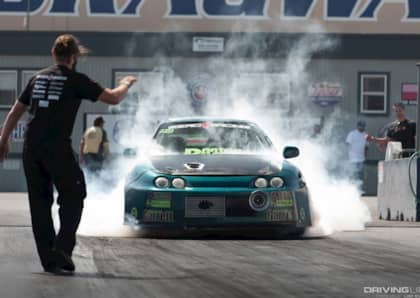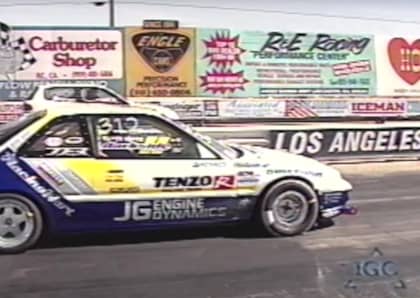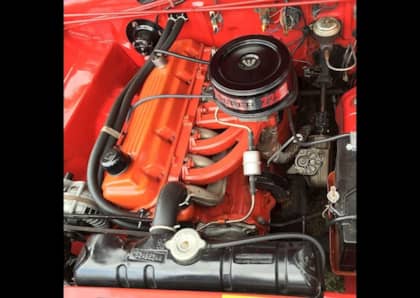Import Face-Off Bakersfield 2015 [Gallery]
If you're a newcomer to import enthusiasm, you’ve probably heard its veterans recall the “glory days” of import drag racing in the early to mid 2000s. Bear with us for a quick recap and some of our favorite moments from this year’s Import Faceoff at Bakersfield, and watch us do our best Tarantino as we connect each storyline at the end. Vets, get ready for a trip down memory lane.

In its day, import drag racing was huge. The NHRA ran a lucrative Sport Compact Series backed by several corporate sponsors, and import-segment series like the IDRC, NIRA and NDRA cropped up with enough popularity to give the NHRA a run for its money (and the best competitors). Drivers of small-displacement imports took traditional hot-rod drag racing by surprise, as their four- and six-cylinder engines broke the 10-, 9-, 8-, 7, and even 6-second ¼-mile barriers.

Six-figure builds were commissioned by the OEMs, resulting in 7-second Pro FWD Honda Civics and Scion tCs and 6-second, RWD-converted Toyota Solaras trapping 210+ mph. Top-16 (if not Top-32) fields were run in seemingly every class, at every race, of every series. Events were televised, drew thousands of spectators and regularly included bikini contests, car hops, trance DJs, foam pits, colored vinyl interiors and other things we thought were cool back then. Import drag racing enthusiasm spawned the birth of the Fast and Furious film franchise, and unless you actually knew Japanese tuning culture and were ahead of the curve, everyone — everyone — who built an import did so to go fast in a straight line. Yes, even 240SX owners.

But as quickly as import drag racing rose to great heights, it all came crashing down. Blame it on the fact that the technology had begun to plateau and the major milestones had been passed, or that pro competition became prohibitively expensive for all but a few players, or that law enforcement caught up with reckless fans on the streets and quelled the groundswell, or the poor reliability of knock-off parts and tuning, or the general rise of drifting. The takeaway is that today, it enjoys only a fraction of the size and fame it once did. And despite what the previous paragraphs might imply, this ultimately proved to be a good thing.

Import drag racing’s unravelling was a lot like building a race car. It was stripped down to the essentials, its driving force (the core racers, shops, tuners) was strengthened, and traction was gained through years of development, information sharing and competition. What emerged is what we enjoy today: Sport FWD cars that rival yesterday’s Pro-class E.T.s and trap speeds, with increased reliability. Locally developed production parts built to take repeated abuse, in place of what was once adapted or hacked together to last one event. 2,000-hp AWD GT-Rs that don’t break. Race teams that have time to get their act together in between semi-annual races, rather than having to scramble to make several races a month.

Slowly but surely, the small segment of automotive enthusiasm that was once looked upon with disdain at its collapse, unruly following and poor reliability is becoming revered for what it’s been doing (amidst a lot of distraction) all along: pushing the absolute performance threshold of some of the most underrated, high-performance cars ever put into production.

As for the events, they also became more efficient. Rather than multiple series competing with each other in trying to cater to everyone, we now have a few big, year-end events for the top guys to freeze their asses off while breaking records and raking in five-figure purses (World Cup Finals, Import v. Domestic, etc.), and Import Faceoff (IFO) for just about everyone else… including those top guys.

IFO hosts dozens of events each year, many in towns throughout the South and Midwest that have traditionally been left out of the action. Lying halfway between LA and San Francisco, squarely in the middle of nowhere, IFO’s annual Bakersfield events are a good litmus test for the entire series. Some really fast contenders will show up from up to a few hundred miles away—be it for shakedown runs, bragging rights or just to have fun—but by and large the field is made of enthusiasts and locally built Sport-class cars looking to settle grudges and blast some passes. There are championship points races in each region (and one nationally), but this seems to concern only a few contenders. Most are in it for the pure enjoyment of racing with each other, in front of friends and family, on a warm summer day. And this time around, more came out than we can remember seeing in past events.

Standouts deserve their recognition, and in Bakersfield those standouts are Lucas English and Alberto Casas in the Forced Induction Pro finals, who respectively blasted out 8.592 sec @ 171.53 mph and 9.005 @ 161.30 passes from behind the wheels of their Mitsubishi EVO X and JZA80 Toyota Supra; TJ Lewton in Sport FWD, laying down a 9.44 @ 161.57 in his conservatively styled red EG Civic hatch; Gio Salinas, whose much more radical FWD-class Sheepy Built EG hatch ran even faster, yet broke in the finals; Jarom Schmidt, who won the round against Gio in his white CRX with a 9.836 @ 161.88; L.A. street racing presence Jerry Guzman, who took All Motor Pro top honors with an easy 10.104 @ 138.09 when his opponent shut down after the light; and Marissa Liongson, who roared out an 11.498 @ 121.39 in her white, K-series EG Civic hatch to take All Motor Sport.

Import drag racing’s glory days may be gone, but its golden years are upon us. And if its current trajectory is any indication, the best is yet to come.



















































































































































































































